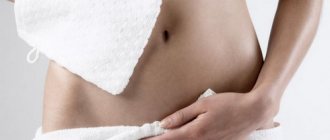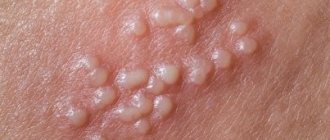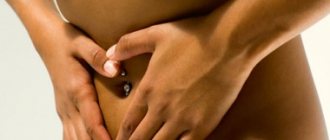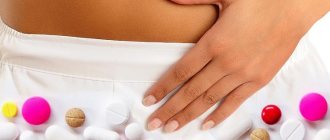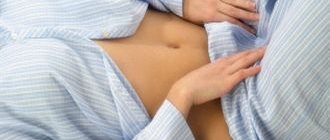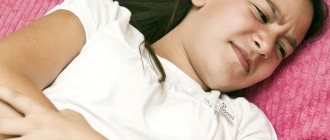Intimate hygiene of a newborn girl - in the first few days after birth, the babies are cared for by maternity hospital staff. They treat the nose and eyes with it, wipe the skin with wet wipes and wash it, and after the child is discharged home with his mother, the responsibility for caring for him falls on her parents.
Due to the fact that the baby defecates frequently, you need to take care of his genitals all the time, doing it correctly.
Mothers of girls need to pay special attention to intimate hygiene, since the specific structure of the genital organs of babies can cause infection if washed incorrectly. [Hide]
How to perform intimate hygiene for a newborn girl?
Proper intimate hygiene is extremely important for the health of the newborn. Adult women have a protective microflora that prevents pathogenic bacteria from entering the body through the genitals; babies do not yet have such protection.
For this reason, an insufficient number of procedures or their incorrect implementation can cause various inflammatory processes and also cause fusion of the labia. All these negative consequences in the future may affect the regularity of the monthly cycle, bearing a baby and the ability to conceive a child.
The very first rule that mothers of girls should learn is that babies need to be washed from front to back. But besides this, there are a lot of other nuances that you should definitely familiarize yourself with. The rules of intimate hygiene for a newborn include:
- Before washing your child, be sure to wash your hands with antiseptic soap;
- Washing should be done in the direction from the pubic area to the anus;
- You need to wash your baby immediately after she wakes up, before going to bed and after each bowel movement. First you need to wash the genitals, and only then the anus;
- You need to wash your baby after every bowel movement. If the mother does not do this, then particles of excrement or urine may get on the mucous membranes of the vaginal vault, leading to an inflammatory process in the vulva;
- The newborn should be washed after each diaper change. After the procedure, the child should be left without a diaper for fifteen minutes so that the skin can breathe a little;
- Hygiene procedures for a child should be carried out without the use of baby soap. It should only be used if the baby is very dirty. Otherwise, the newborn should be washed with warm water or chamomile infusion;
- The girl should have her own baby soap, towel and sponge;
- When washing, you should not use a washcloth, as it can lead to injury to the mucous membrane of the genital organs;
- After washing, you should carefully blot the girl’s labia, avoiding friction, which can cause irritation;
After the procedure, you need to treat the genitals with a special oil or cream for babies. They also need to lubricate the child’s inguinal folds.
What is required from a mother
Only one thing is required of her - to diligently observe the requirements of cleanliness, and in particular sexual cleanliness. Washing must be carried out in a certain order - from front to back. First, the genitals are washed. Then you should move to the anus. The water should be warm, boiled. Some recommend using a warm chamomile decoction for this.
You should not try to remove hydrocele - a white coating between the labia majora and minora. In general, parents should remember that the baby’s mucous membrane is in a vulnerable state, so they need to act very carefully.
In addition to washing, let the child's genitals breathe a little. Therefore, several times a day, let your child lie naked for a couple of minutes. Without any diapers or diapers.
Postpartum discharge in a newborn girl
Many mothers believe that newborns simply should not have any vaginal discharge, so when they see whitish or bloody mucus, they are alarmed. This physiological process should not cause concern, but only if it was noticed in the first few weeks after birth. Discharge during this period causes the so-called sexual crisis of the newborn. They may have a white, yellowish or bloody tint, which is absolutely normal and should not frighten parents.
This condition lasts up to two weeks, although it can last up to two months. In addition to the discharge, there is swelling of the labia, engorgement of the mammary glands and rashes. Such phenomena are associated with an excessive amount of female sexual secretion, which the baby received from the mother at birth. It is through such frightening symptoms that it leaves the child’s body
The discharge does not cause discomfort in the baby, but still, when it appears, it is necessary not to forget about enhanced intimate hygiene of the newborn girl. You should wash the baby according to the same rules as described above. But the procedures need to be carried out more often than usual, using warm boiled water or chamomile decoction for this purpose.
Diapers
Many questions related to the hygiene of girls concern the use of diapers. On mommy forums there are often opinions about the harmfulness of diapers. Is it so?
As you know, liquid feces getting into the vagina is the main problem of girl hygiene. This often provokes infectious processes and inflammation. With the advent of diapers, the scale of the problem decreased. This is evidenced by the statistics of doctors and many years of experience in using diapers.
Modern diapers perfectly absorb moisture, have antibacterial properties, including moisturizing the skin, etc. You can read more about diapers here.
If you constantly use diapers, then you should wash your baby in the following mode:
- after the toilet “in a big way”;
- while bathing before bed.
The only important condition regarding diapers is their regular change, at least once every two to three hours.
Don’t be afraid to use diapers: they are absolutely not harmful to babies; on the contrary, they reduce the risk of liquid feces getting into the vagina, which means they reduce the likelihood of getting inflammation
Is whitish mucus between the labia normal or pathological?
You shouldn’t be overzealous with your baby’s intimate hygiene; it should be sufficient. There is no need to focus on your child’s hygiene procedures. The discharge should be monitored and changes noted if any are observed. You need to wash the baby very carefully. The labia should only be spread if necessary, and done very delicately. Inaccuracy in this matter can lead to their merging.
What should I do if my mother begins to notice white discharge accumulating between the labia majora and minora? Is this normal? How to behave in this case and is it worth removing them?
White discharge is a secretion produced by the glands of the labia. It is used to protect the child’s genital tract from pathogenic microflora and does not need to be removed. In general, you should not spread your baby’s labia apart unless necessary. However, if powder or baby cream has accumulated there, they can be carefully removed with a cotton swab dipped in water.
Causes
What can cause an increase in the growth of colonies of the Candida fungus and lead to thrush in girls and how is this disease treated?
First, let's look at the most common reasons:
- general somatic infectious processes;
- impaired blood supply to the pelvic organs;
- pathology of endocrine genesis;
- agranulocytosis;
- development of anemic conditions;
- disturbance of intestinal microflora;
- vaginal dysbiosis.
At what age should intimate hygiene be taught?
Over time, the baby will begin to grow up and when she reaches one year of age, she can already be taught to perform intimate hygiene independently. Mom can explain the whole process on a doll or with her own example in the shower. However, it should be taken into account that girls closely monitor the actions of adults and imitate them, therefore, when the baby is around, the mother should not put tampons or change pads, otherwise the child will definitely repeat this, which can lead to serious injuries to the genitals.
The rules of intimate hygiene for a child starting from the age of two are based on the same aspects as before. However, it should be noted that, unlike a baby, a two-year-old baby must wear underwear that will protect her genitals from pathogenic bacteria. It also needs to be explained to the baby that she should not touch the genitals, especially with dirty hands, as it can cause infection.
The baby can already perform hygiene procedures on her own, but doing it under the supervision of her mother. She needs to prepare personal hygiene products in advance and place them in a place convenient for the baby.
Your child needs to change his underwear twice a day. At night, a girl can be allowed to sleep in her pajamas without panties. During the day, the child must wear panties, as they will protect the genitals from dust and pathogenic microflora.
Diagnostics
Before treating thrush in a little girl or teenager, the doctor needs to conduct a comprehensive examination, which includes:
- gynecological examination;
- taking swabs for testing;
- ultrasound diagnostics of the pelvic organs.
If, during an external examination, a specialist detects redness or swelling of the vaginal mucous membranes, then the presence of candidiasis can be confirmed using microscopic and laboratory tests (ELISA, PCR, bacteriological culture).
Thanks to such methods, it is possible to detect candida fungi, as well as carry out differential diagnosis with other possible types of pathogens.
Ultrasound examination makes it possible to determine the extent of the disease and the involvement of other organs.
Prevention
In women, prevention of diseases of the reproductive system should be comprehensive.
- Careful hygiene of the reproductive organs using special intimate hygiene products. You need to wash yourself with movements from front to back to prevent the introduction of bacteria from the intestines.
- Regular change of hygiene products. Sanitary pads need to be changed every 3 hours.
- Wearing comfortable underwear.
- Prevention of infections transmitted during intimate life. It includes protection during sexual intercourse, especially if the partner is unstable. Careful hygiene after sexual intercourse is required.
- Boosting immunity.
- Reducing the amount of sweets in the diet.
- Explaining personal hygiene rules to girls.
Traditional methods
To remove the symptoms of thrush, you can use traditional methods in combination with traditional treatment of candidiasis, but only after consulting a doctor.
The following decoctions are most effective for washing the external genitalia:
- Infusion of medicinal marigolds. Pour 20 grams of dried flowers with a liter of boiling water and place in a dark place to infuse.
- St. John's wort decoction. 3 tbsp. l. Pour dry collection into an enamel pan, add 2 liters of water, put on fire and bring to a boil.
- A decoction of linden and oak bark. For 3 parts of flowers, take 1 part of oak bark and pour boiling water over it. After infusion, use for washing.
Diagnostic measures
First of all, you need to pay attention to the accompanying symptoms that appeared along with the discharge. If disturbing symptoms are observed, it is better to seek help from a gynecologist to find out why the white plaque appears.
The doctor will examine the woman and prescribe the necessary tests. Most often, the doctor diagnoses the pathology using a smear from the cervical canal. It is carried out to identify urogenital infections, syphilis, and also using a smear to evaluate the internal environment of the vagina (the presence of bacteria, fungi).
